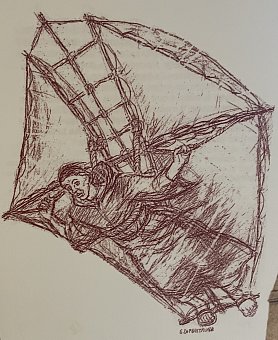Graham Reid | | 3 min read

Because I once wrote an extensive travel-cum-history article about going in search of the 15th century Italian, Saint Joseph of Copertino, who flew, I'm always interested in stories about ancient aerialists.
As I mentioned in that article The Idiot Boy Who Flew (he was a simpleton but apparently could take to the air), flying saints aren't that uncommon: medieval towns on the pilgrimage trails derived income from travelers so you needed to have something to make them come to yours.
Maybe a holy relic, a saint who could perform miracles or, like St Joseph, a saint born in a manger who flew.
So it was a bit of a business side-hustle if you will, for the Catholic church.
Then there are the interesting others who tried to fly, or at least looked into the possibility. Like Leonardo Da Vinci.
However in the lovely small English town of Malmesbury about an hour north-east of Bristol I came upon another ancient aerial adventurer. And he too was a monk.
Almost exactly 900 years before the Wright brothers a young monk in Malmesbury took to the air.
 Malmesbury is a beautiful town with a fine abbey which boasts extraordinary carved stonework, a handsome vaulted roof, excellent stained glass (some pretty recent) and the tomb of Athelstan, the first king of England in 925AD.
Malmesbury is a beautiful town with a fine abbey which boasts extraordinary carved stonework, a handsome vaulted roof, excellent stained glass (some pretty recent) and the tomb of Athelstan, the first king of England in 925AD.
The good folk of Malmesbury rallied around him to fend off the invading Danes.
In the 15th century the abbey was huge as illustrations inside of it today show.
 But it was the flying monk who interested me just as much as the extraordinary history in the stones.
But it was the flying monk who interested me just as much as the extraordinary history in the stones.
In the little museum the story of the monk Eilmer is told.
According to the 11th century historian William of Malmesbury, Eilmer really did fly. It was possible.
By modern calculations if he had launched himself into the south-west wind he would have been able to ride air currents to a nearby hillside.
The date of his flight – 1006AD – is considered accurate because Eilmer saw Halley's Comet in 989AD when, we assume, he was about six for him to have remembered it.
It seems more likely that Eilmer most probably hit a bit of a headwind when he launched himself and was blown sideways into what is known as Oliver's Lane.
 He was certainly brave.
He was certainly brave.
According to William of Malmesbury, “in his early youth [he] had hazarded an attempt of singular temerity: he had . . . fastened wings to his hands and feet in order that he might fly . . . and collecting the air, on the summit of a tower, had flown the distance of a furlong [200 metres]; but agitated by the violence of the wind and the current of air, as well as the consciousness of his rash attempt, he . . .”
Okay, you know where this going, right?
“He fell and broke both his legs”.
 We must assume that was probably end of his career as an aerialist.
We must assume that was probably end of his career as an aerialist.
There's always a punchline with these flying folk.
Simple St Joseph -- who apparently couldn't tell brown bread from white -- is the patron saint of pilots, air travelers and astronauts.
And the enthusiastic Eilmer attributed his failure to . . . the lack of a tail.
.
For other travels stories at Elsewhere start here.
Some are serious, some far from it.
.

.






post a comment